Do you speak Yerkish, the language of monkeys?
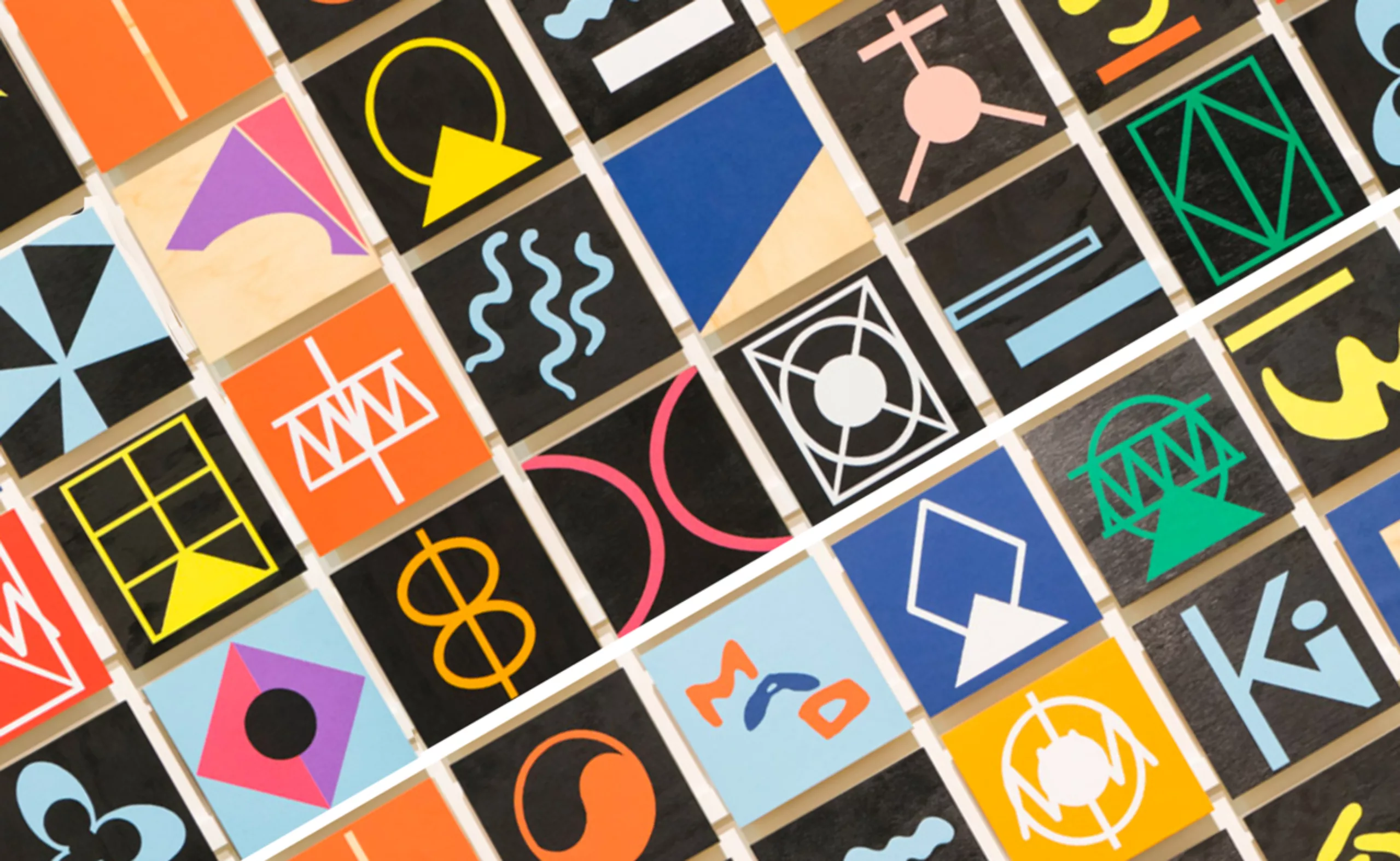
At Graphéine, we love words, languages and writing systems. We recently told you about Unicode, which standardizes the world’s languages with numbers, about the Persian alphabet, which poses problems for typographers, about racist typography, which stereotypes cultures, while telling you about the origin of the most famous typographies in the Typorama series.
But do you know the yerkish, the visual language to communicate with the great apes ?
Communicate with monkeys
At the beginning of the 70’s, researchers were interested in primates and tried to find out if it was possible to make them learn a language in order to communicate between distant cousins. At that time, we don’t like the idea of losing our status, and we defend the idea that language is the property of man. The rules of grammar and syntax, the symbols and their meanings would only be acquired by humans. It has been shown that many other animals and even plants are capable of exchanging information and communicating, although spoken and articulated language remains unique to humans.
Sign language
Although apes are clearly not able to control their vocal chords and articulate sounds to “speak”, they are nevertheless skilled with their hands and know how to observe and repeat. In the United States, the Gardner couple tried to communicate with Washoe, a chimpanzee, by sign language in 1966. Over the years, Washoe was able to use over 200 signs to make himself understood. Nevertheless, the use and understanding of this “language” being judged biased by the family’s affect towards the primate and the human interpretation, in addition to being limited by a lack of syntax, scientists disapprove of this study. In 1972, it is the gorilla Koko who will make sensation, by mastering in the years 2000 more than 1000 signs of the American sign language. You can learn sign language with Koko online.
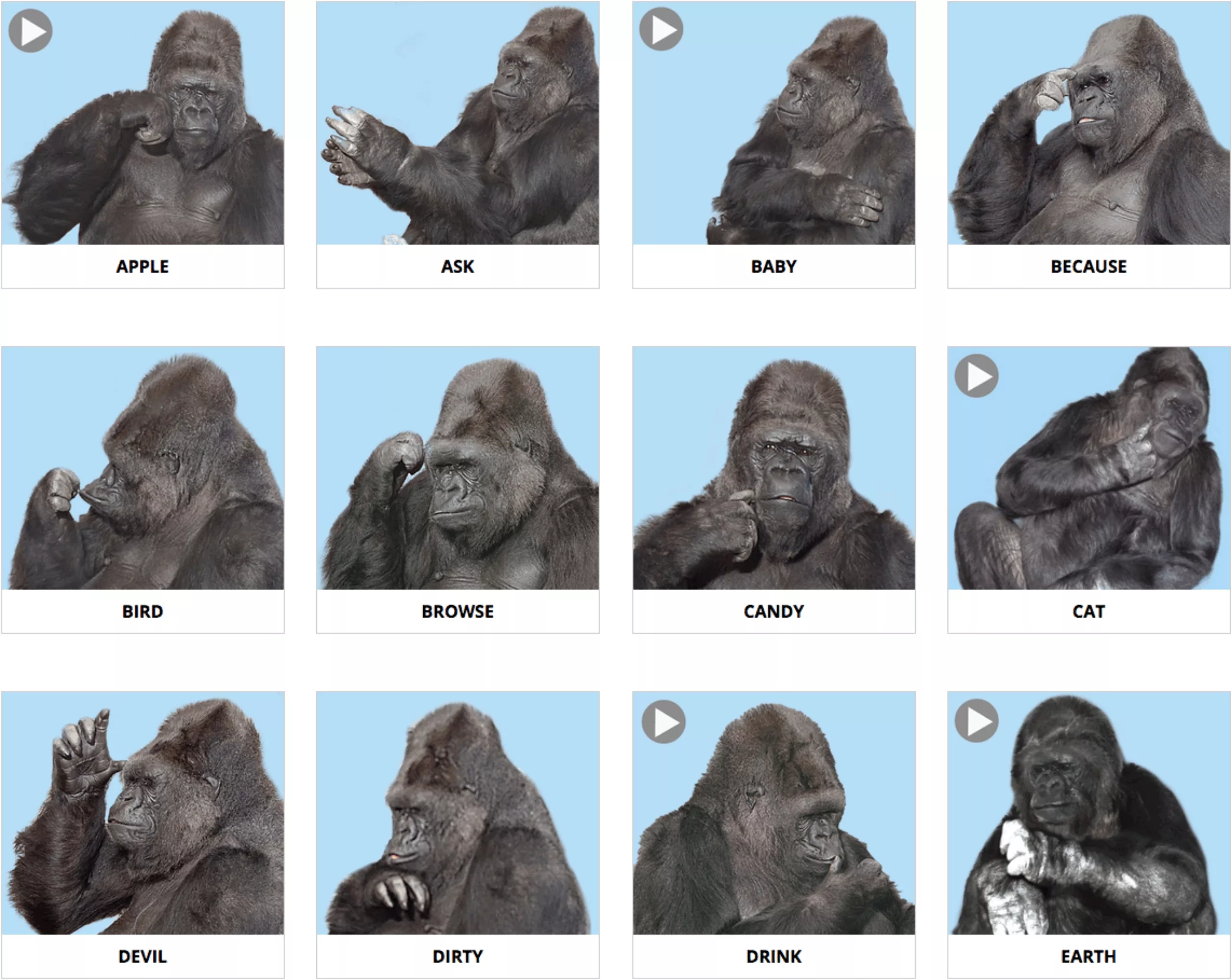
In the early 1970s, the Georgia State University of Language Research sought a reliable and measurable alternative to study another possible form of language between monkeys, unvocal and unbiased.
Symbols to communicate with monkeys
In 1969, the Premacks proposed a visual language system based on magnetic plastic shapes that Sarah the monkey could arrange on a board. David and Ann James Premack wanted to prove that language is a means of expressing pre-acquired concepts that are then translated into words (or signs), not the other way around. For them, language is not simply the repetition or acquisition of signs. It is primarily a matter of conceptualization. So they try to create situations to stimulate language. Below we see the symbols used to represent nouns, adjectives or concepts, which the monkey assembles according to the situation. These visuals are from the study Teaching Language to an Ape by Ann James Premack and David Premack. You have to imagine them in color.

Sarah is shown signs and the primate has to differentiate the objects (similar/different) or describe an object represented by a sign with other objects that are meaningless. For example, a blue triangle means “apple”. When shown this blue triangle, which Sarah identifies as the symbol for an apple even though there is no real apple in front of her, she can reconstruct something that looks like an apple with a red circle for example. She thus assimilates that the blue triangle is not descriptive, while the red circle is. The concept of an apple is pre-acquired, and she uses shapes to represent it. Here are examples of sentences representing the colors of objects, or their differences.

The Lana project: digital communication
At the beginning of the 1970s, the researcher Duane Rumbaugh and his team decided to go further and use a new invention that was revolutionary at the time for their research: a computer keyboard. This one allows to add a syntax. The computer makes it possible to record all keystrokes without human error, and to avoid subjective interpretations.
Rumbaugh thus develops a kind of visual language -without any sound- with the help of Ernst von Glasersfeld, a philosopher. The yerkish was born (in homage to Robert Yerkes, a pioneer in primatology). This new language for primates will be used to see if it is possible to exchange “sentences” composed of symbols between a researcher and some bonobos or chimpanzees chosen as guinea pigs. The first monkey to have done this is a monkey named Lana. An eponymous project is dedicated to her: the Lana Project.

The monkey is placed in a plexiglass room next to the researcher’s, both of which have a computer with a keyboard. On one wall there is a large keyboard, whose luminous keys are displayed when typing, and whose sequences are transcribed on a small screen. Following precise grammar rules, the researcher teaches the monkey to formulate sentences to obtain food or other rewards from a dispenser. With each correctly performed combination of symbols, Lana receives M&Ms, a sweet potato, or music or movie clips. “PLS Tim give Lana sweet potato”. After six months, Lana becomes food independent from the man. We can see the success of the experiment by the progressive weight gain of the primate…
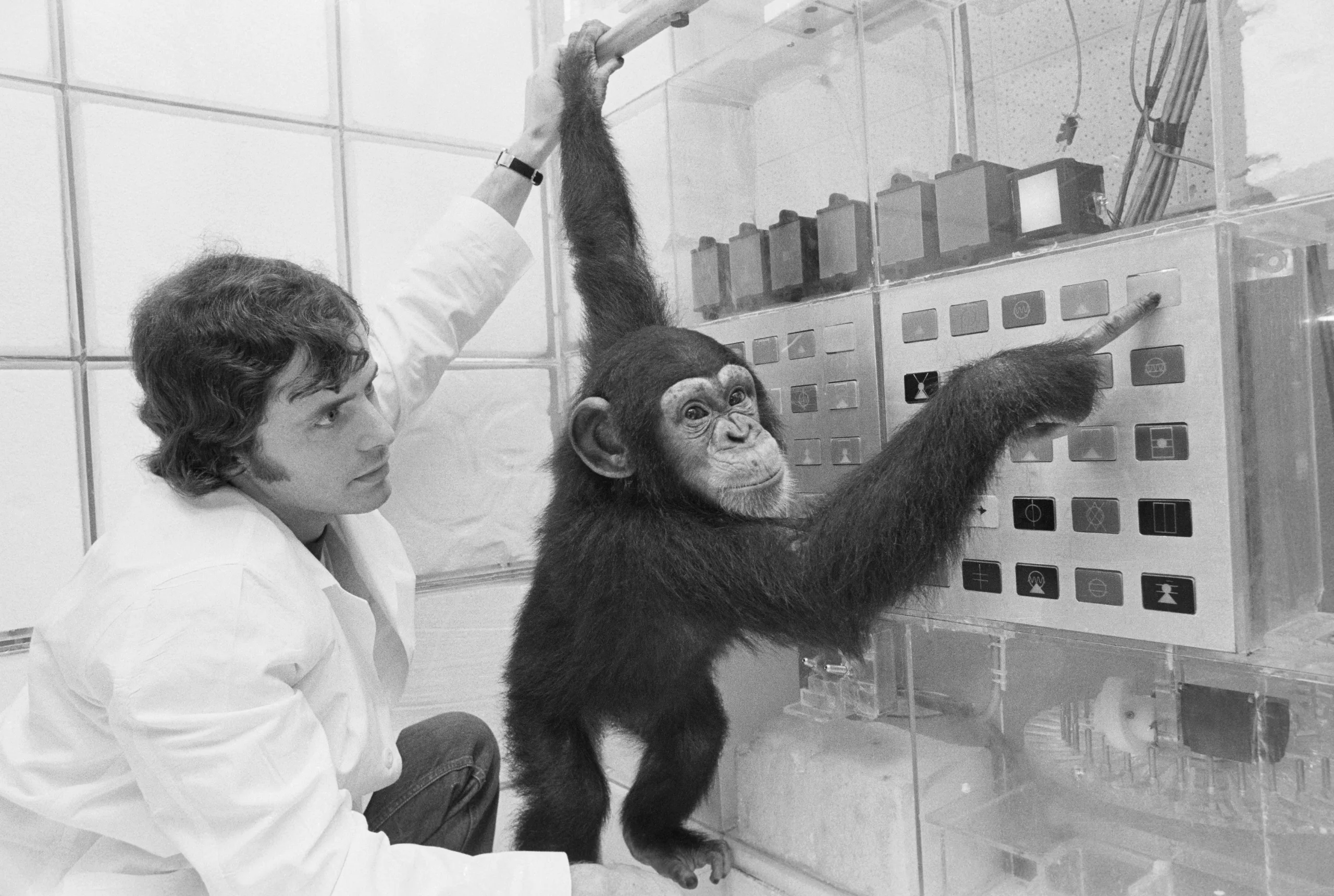
Inventing a language that cannot be spoken: Yerkish
For the Lana project, Ernst Von Glaserfeld invented geometric symbols that he called “lexigrams“. These are logograms made of 9 basic symbols that can be assembled to create new words. Unlike pictograms, which visually symbolize concrete elements, logograms are abstract : they have no meaning or pronunciation.
Here is the initial design, from the Yerkish Language for non-human primates published in 1975 and available here in pdf. We see first the 9 logograms, then lexigrams combined to form words. The design is simple and uncluttered and reminds a bit of nautical language.

The lexigrams are divided into semantic subcategories : what to eat, body parts, activities, objects, subjects… The whole is wrapped in a color code that supports these acronyms. Thus, the subjects are in purple, what is eaten is in red and the parts of the body are green. We say yes with a white symbol, but we ask for something or we say no with yellow. The acronyms are deliberately purely symbolic so that it does not appear that the monkey understands an image or a word.

With a simplistic grammar modeled on the language of experience – English – Yerkish has a very simple system of correlation to link words and form sentences (LANA – EAT – RAISIN). The researchers add to this four forms, the indicative, the interrogative, the imperative and the negative. These forms are defined by the order of the words or symbols added at the beginning of the sentence such as “?” or the “arrow” key that indicates a request, and the period that ends the sentence.
Lana can write for example:
“TIM EXIT ROOM.”
“PLEASE TIM EXIT ROOM.”
“? TIM EXIT ROOM.”
“NO TIM LEAVE ROOM.”
to say 4 different things. The keys also suggest spatial prepositions (inside, outside, above, below…) adjectives or various nouns. One key is used to ask the name of things “name-that-thing”, so that the monkey can develop its vocabulary. Spontaneously, monkeys who have used yerkish or sign language have also been able to invent words of their own accord by associating them with each other, for example “orange-colored apple” to designate an orange, or “water-bird” to refer to a duck.
Ernst Von Glaserfeld is pleased with the results of this study (Les chimpanzés et le langage, La Recherche, n°92 – September 1978, pp. 725 to 732). “For some scientists, Lana’s performance is nothing other than an instrumental conditioning: when she presses the keys of her keyboard, she behaves like B.F. Skinner’s pigeons who were taught to run a course in eight to obtain a reward. (…) But Lana does not accept water when she has formed the following command on her keyboard: “Please machine give milk.” When, for the purposes of the experiment, the fact occurs, Lana immediately protests by writing sentences of this kind: “Not milk in machine”, or: “You put milk in machine”, or: “You take water out of machine.” So Lana has learned that each sequence of lexigrams leads to a different result : in other words, that each has its own meaning.”
Kanzi superstar of yerkish
Over the years, these symbols evolved and the vocabulary grew. In the 1980s, the Kanzi monkey became the great star of the yerkish, somewhat by chance. Originally, it was his mother who was the subject of the study. Kanzi was still a baby and did not have to interact with the scientists. When his mother leaves, at 30 months, he spontaneously starts pressing symbols (now on a computer screen) to communicate with humans. Unlike Lana before him, Kanzi evolves in a natural environment and the primatologist who studies him, Sue Savage-Rumbaugh, constantly moves around with a grid of Yerkish acronyms to teach them to the monkey. Above all, Kanzi learned by mimicry at a very young age.
Sue is the first and only scientist to have studied the language of bonobos. She has helped develop new technologies to accompany their development. For example a keyboard that synthesizes speech, or a joystick to automate computer tasks. A few years ago, an application to speak Yerkish with the monkeys was almost born, without success. Savage-Rumbaugh now works at a specialized sanctuary for great apes, after devoting 23 years of his life to Georgia State University’s Language Research Center (LRC).
With the portable yerkish grid, or with the help of an iPad, the bonobo can put words on objects, or demand marshmallows be toasted over a fire on a walk in the woods (true). And because Kanzi was raised with humans and yerkish, he also understands spoken words, which he responds to with symbols. In total, he uses a vocabulary of about 400 signs, just as much as a 2 year old child.
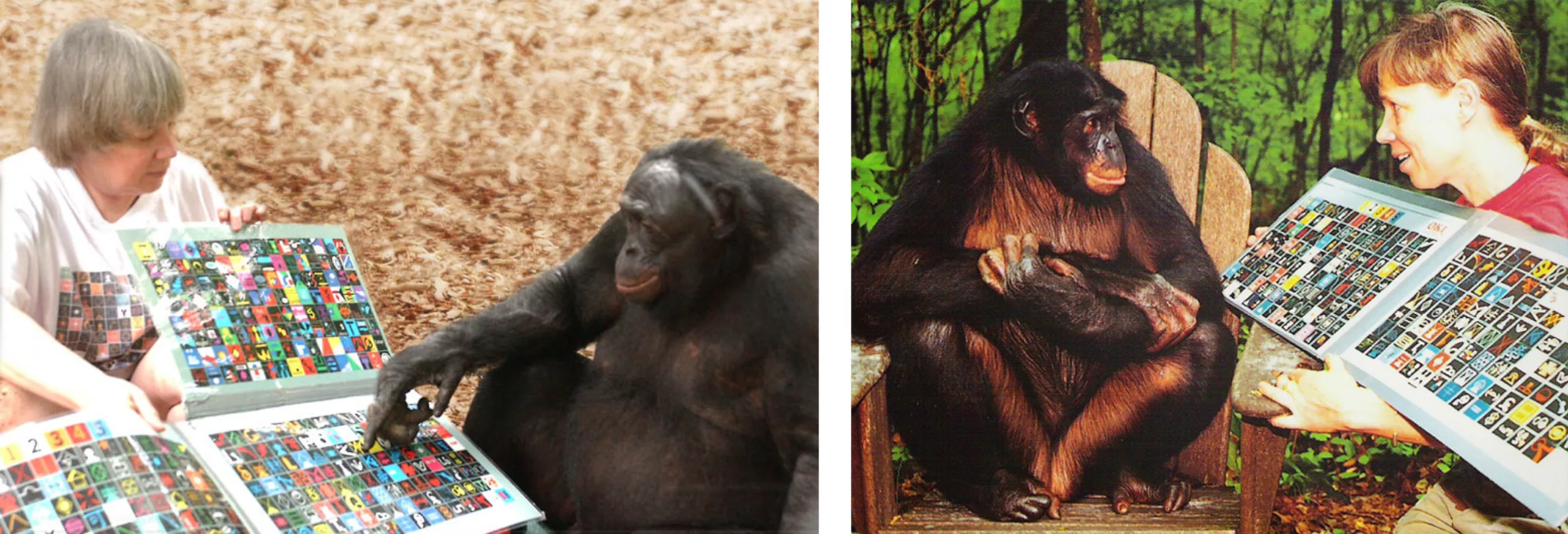
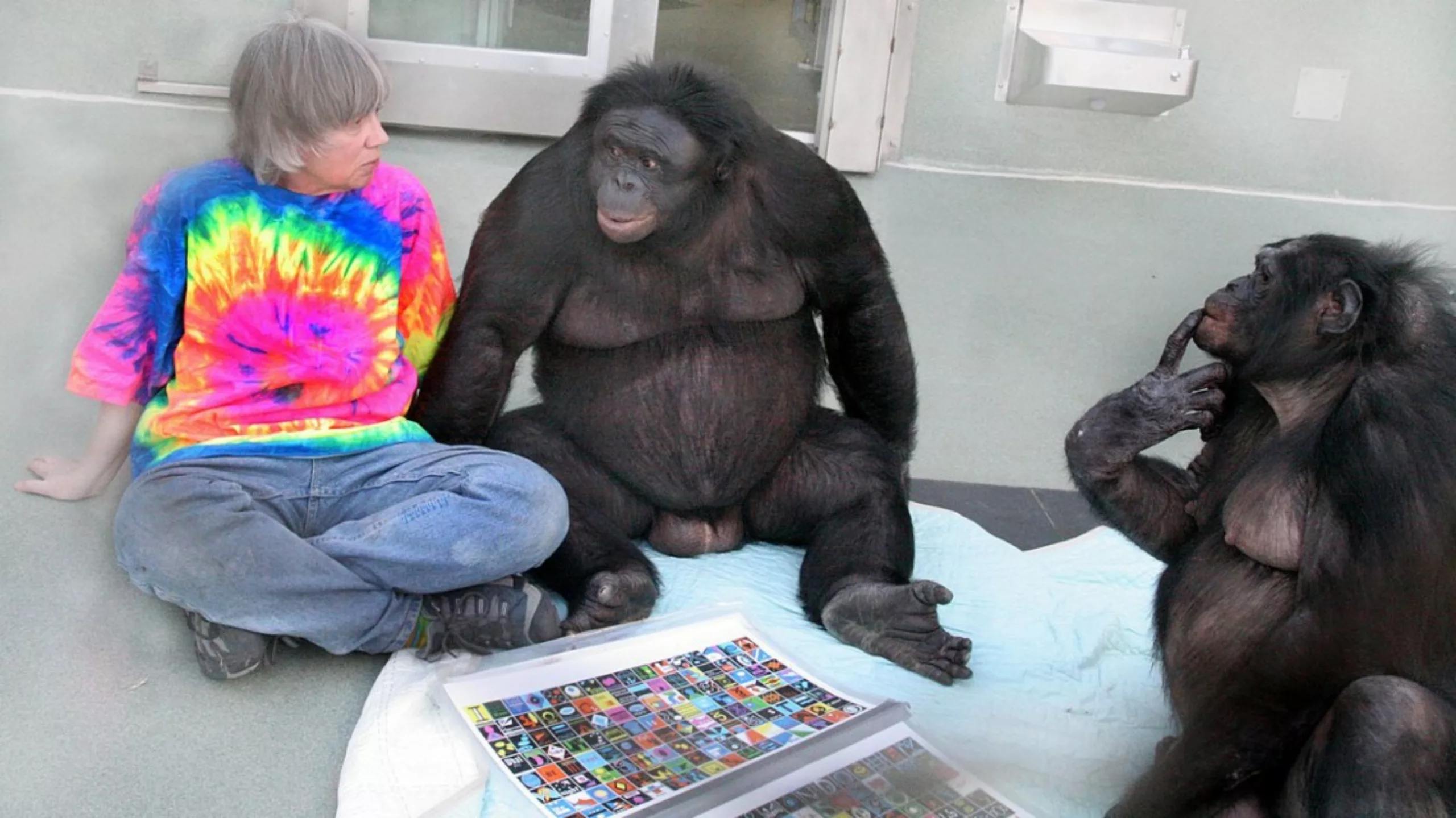
We can see here Kanzi pointing out the lexigrams corresponding to the words we say to him. We can acclaim his visual memory.
For those who are interested, Kanzi is now in a bonobo study and research center and has lost more than 35 kilos. We are happy for him!
Modern monkeys drink Perrier
We have not found the source or the logic for the creation of the new Yerkish lexigrams used today to communicate with the great apes. It seems that von Glaserfeld’s symbols are now mixed with Premack’s (the colored plastic shapes we talked about at the beginning). Sometimes there are some texts or even logos. There were 125 lexigrams at the time, and about 400 today. Among the new acronyms, we distinguish the logo of Perrier for example (?!).
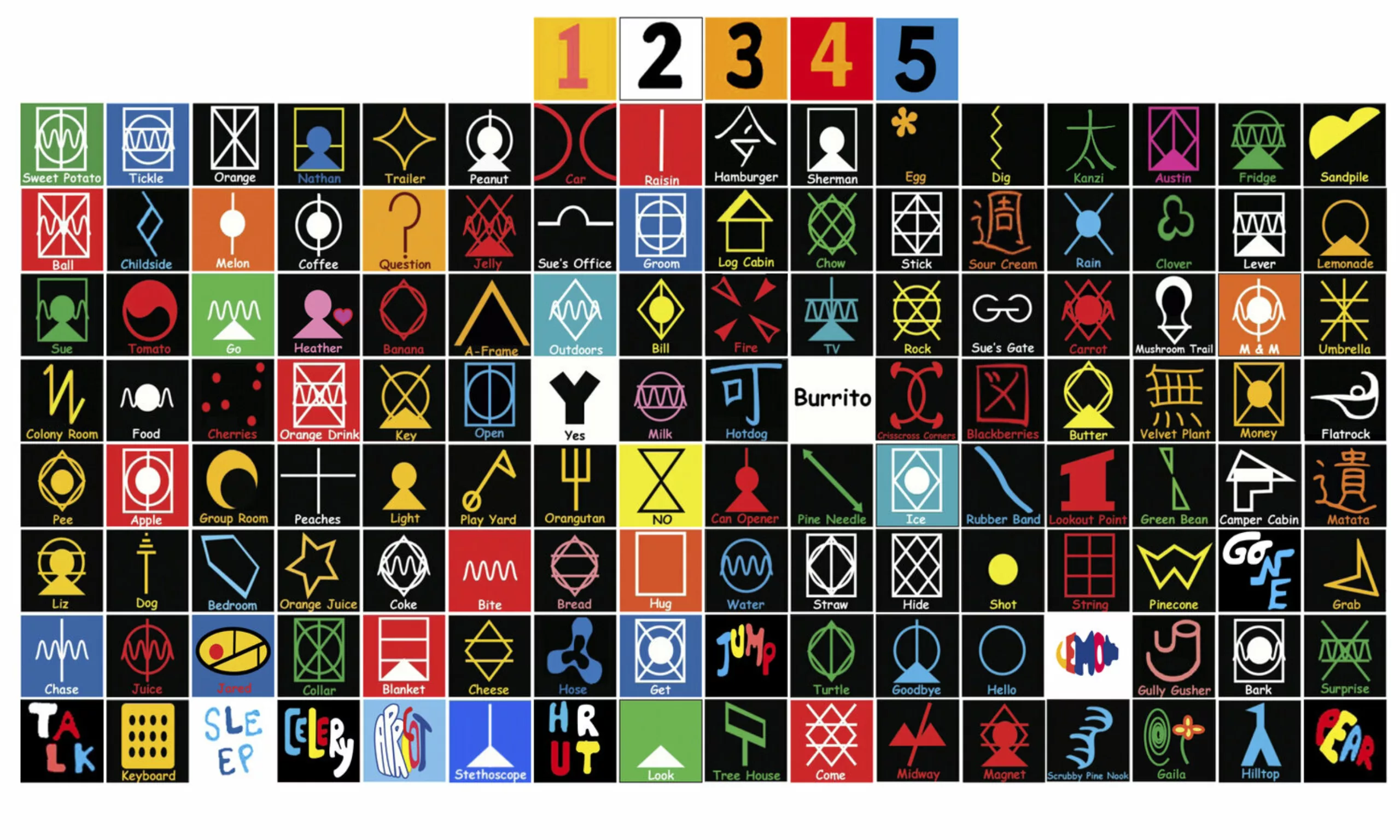
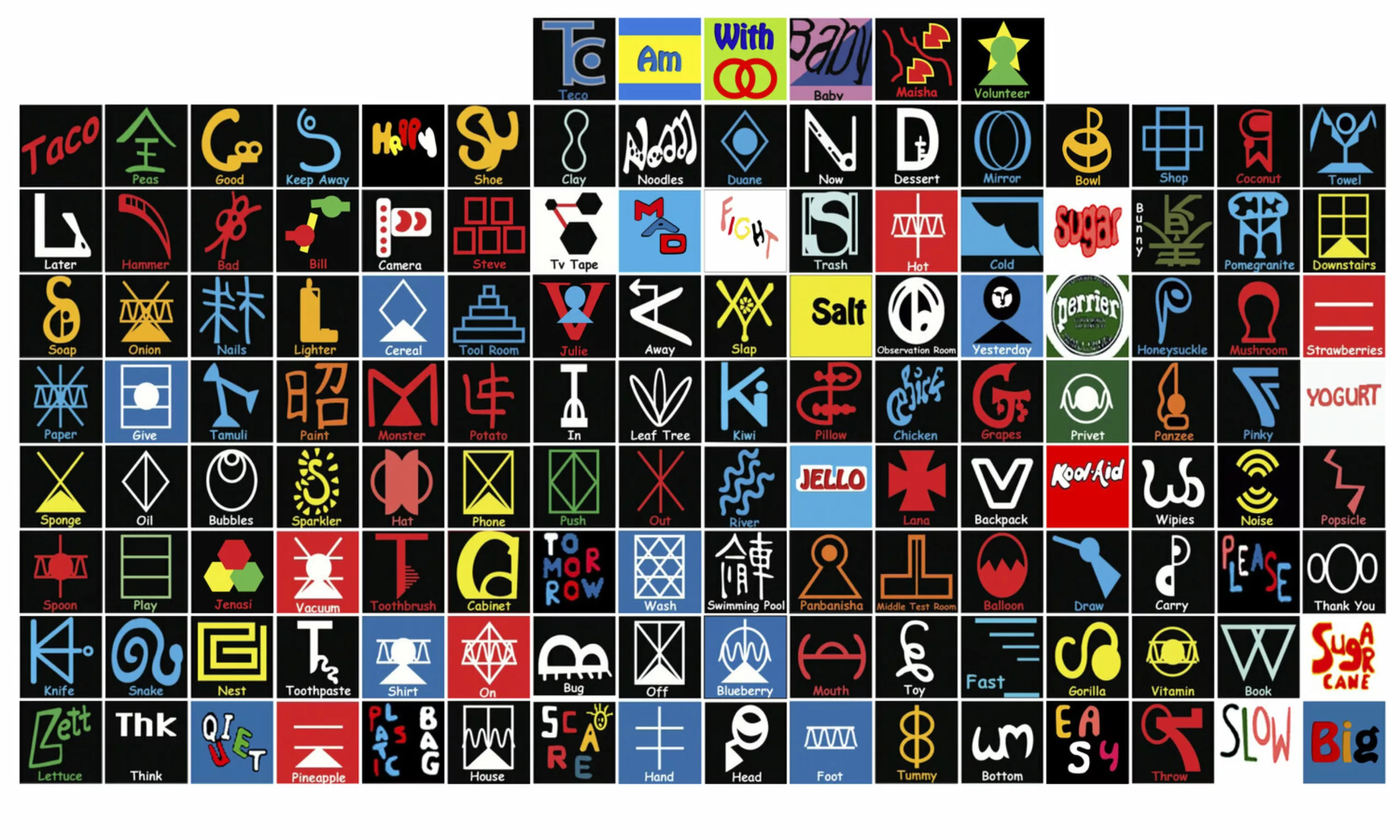
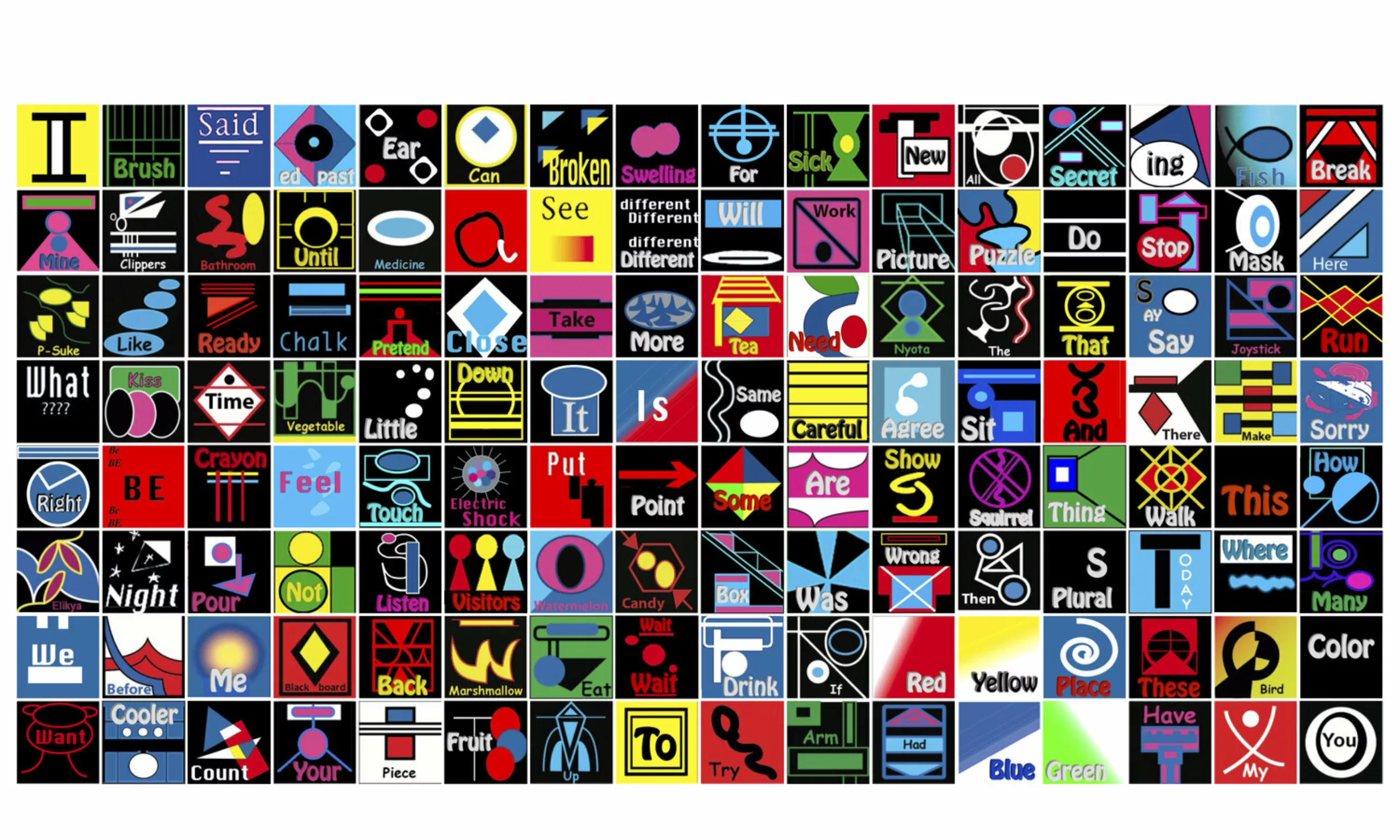
More designers for primates
We wonder what happened in the design team to go from the original lexigrams to these (personally, I think there is simply no creative team anymore!). Yet Ernst von Glasersfeld wrote in 1975 when he explained his design process that “each key represents a word, represented by a geometric design (…) These lexigrams each correspond to a concept : unlike English words, they can only have one meaning.” Therefore, it was not originally intended to have a word to form lexigrams, in order to be univocal.
In addition, the geometric form divided into semantic subcategories originally conceived allowed the symbols to be combined to illustrate concepts. The new signs, on the other hand, seem to be made perfectly randomly and without any logic (or else to make a symbol without any logic!). The signs are random and seem to resemble everything but the concept in question. The verb “to count” looks like a Mondrian painting with a constructivist twist, its neighbor “to want” looks like a big soup tureen on legs. “Forgive” is like a slice of fallen pizza with onions scattered on the floor, and “medicine” looks like a swimming pool. Only the fish looks like a fish… strange.
It’s probably to be really sure that the monkey doesn’t “cheat” that we didn’t offer him any figurative visuals. It is necessary to keep in mind that men also use this language to communicate, and that they have to break their heads too.
Monkey friends: save the scientists!
Especially when you study other visual languages (such as Bliss or Hobo, which we’ll talk about another time), you think that if designers had worked on the new series of yerkish, they could have invented symbols that made sense or at least had a logic, a semblance of harmony. If it is obvious that monkeys can’t read, then letters are for them simple symbols without meaning. A bit like the Balinese letters or any other ideogram for a stranger to these scripts. We can then ask ourselves why the researchers have developed such a visually complicated language by mixing colors, shapes and letters?
Under the pretext that the monkeys will not have, in any case, any sign of reference, why not have chosen simpler symbols or even letters, with a color chart, to make the whole less visually aggressive? If we admit that the great apes have the capacity to understand as many concepts as a 2 year old child, and if we make a parallel, I am not sure that we would inflict this kind of symbols on children. One would rather wonder how to make sure that they memorize them, that they are beautiful and fun to look at. After all, monkeys are not children. But as distant cousins who, moreover, do not live in an RGB world and are supposed to live in the wild, the yerkish chromatic and garish range might be worth revising. It’s almost cruel, we wouldn’t wish it on a human or a monkey! So, designers and monkey friends, maybe it’s time for you to change things.


